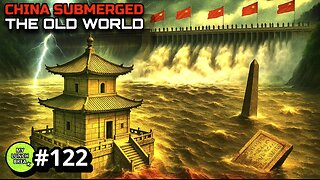Premium Only Content

Strangest Lakes In The World HD 2023
Strangest Lakes In The World
We are blessed by nature with beautiful landscapes that keep visiting them from time to time. This video features some of the amazing but strangest lakes from around the world. From boiling waters to breathtaking landscapes, from pink lotus flowers to blood red hues, from submerged cities to beautiful cities, our list of strangest lakes are nothing like the average body of water, there are many surprises!
Jellyfish Lake In Palau
In the heart of the Pacific Ocean, the island of Palau in Micronesia is home to one of the world’s most stunning lakes. In the lake’s six hectares of brackish waters, once connected to the ocean, there are nearly eight million frolicking jellyfish that are not harmful to humans.
Lake Resia
In 1950, the small town of Graun, in northern Italy, was swallowed up by flooding when two lakes merged to form one large lake of 2.5 square miles. Since then, Lake Resia has completely covered the former town; only the enigmatic bell tower remains visible.
Lake Superior: Surfer’s Paradise
And you thought it was impossible to surf on a lake! Canada’s Lake Superior is so massive that waves build up and transform this cold body of water into a playground for the most enthusiastic and daring surfers. It’s a lake disguising itself as an ocean!
Boiling Lake in Dominica
The second-largest boiling lake in the world is found on the Caribbean island of Dominica. Its water reaches a temperature of 212 degrees Fahrenheit, thanks to carbon dioxide and sulfuric gases that are emitted from the bottom of a large crater.
Man Sagar Lake
Man Sagar Lake is an artificial lake in Jaipur, Rajasthan, India, in the middle of which stands an enchanting palace—the Jal Mahal (meaning “water palace”).
Spotted Lake
Spotted Lake, located in British Columbia, in western Canada, is remarkable for its large puddles in shades of blue and green—hence the name.
Erta Ale Lava Lake
One of the world’s strangest lakes is found at the summit of Ethiopia’s Erta Ale volcano—a molten lava lake that overflows on a regular basis. This explains the name of the mountain—Erta Ale means “smoking mountain” in Afar.
Pitch Lake
Trinidad and Tobago is home to a most unusual lake: Pitch Lake, one of the largest natural asphalt lakes in the world, with a surface of 40 hectares and a depth reaching up to 246 feet.
Laguna Colorada
Located on the Bolivian Altiplano, along the Chilean border, the Laguna Colorada is a blood red tinted saltlake. Its strange color is caused by sediments and the pigments of certain micro organisms found in the lake.
Don Juan Pond
Don Juan Pond is a small lake located in Wright Valley, Antarctica, that never freezes despite the area’s frigid temperatures. It is due to an extremely high salinity level. Don Juan Pond has 18 times the average salt content of the ocean, and more than double that of the Dead Sea.
Lake Balkhash
With a surface area of over 6,000 square miles, Lake Balkhash is the largest lake in Kazakhstan. This majestic body of water is all the more impressive for the fact that its waters are divided in two by a strait, with fresh water on the west side and salt water on the east.
The Lakes of Kelimutu
There are three lakes at the top of the Kelimutu volcano, on the island of Flores in Indonesia. While all part of the same crater, each of the three lakes is a different color, and these colors change periodically—they might be blue, green, yellow or black. It’s a scientific enigma!
Lake Nong Han
Lake Nong Han, in northern Thailand, has a magical charm—from October to March, thousands of pink lotus flowers come into bloom, creating a floral covering on top of the lake. The effect is beautifully poetic.
The Dead Sea
Technically, the Dead Sea is not a sea, but rather a salt lake, located between Israel and Jordan. The hypersaline water allows for easy, nearly weightless floating, along with natural benefits that make the area a destination for those seeking thermal treatments.
Lake Manicouagan
Known as the “eye of Quebec” due to its striking circular shape, Lake Manicouagan, in central Canada, was originally a crater formed by the impact of an asteroid. When a dam was constructed on the Manicouagan River, the crater was flooded, creating one of the largest reservoirs in the world.
-
 14:59:18
14:59:18
Total Horse Channel
20 hours agoWinnemucca Spring Spectacular Cow Horse Show and Derby - Saturday
60.7K5 -
 LIVE
LIVE
After Work Gaming
9 hours ago $1.71 earned“🍺 SOJU SATURDAY “🍺 THE FINALS SEASON 6
124 watching -
 19:01
19:01
Russell Brand
15 hours agoTheo Von Just SHOCKED EVERYBODY With His Take on Trump Tariffs
111K125 -
 14:22
14:22
Tundra Tactical
10 hours ago $5.71 earnedTRUMP DOJ Decides CZ Scorpion Is A Decepticon.
53.7K18 -
 4:53:37
4:53:37
Culturama Podcast
8 hours ago $6.22 earnedEaster Special! Hollow Knight Stream!
48.6K4 -
 1:04:29
1:04:29
Sarah Westall
11 hours agoThe Philippines and Massive Stores of Gold for all the People of the World w/ Joseph Allain
67K48 -
 17:23
17:23
Exploring With Nug
20 hours ago $7.61 earnedCorvette Found Underwater! Continuing The Search For Laresha Walker!
56.2K2 -
 3:06:31
3:06:31
Damysus Gaming
8 hours agoWeaving into the Deep South: South of Midnight First Play! Part 2
14.6K2 -
 24:55
24:55
MYLUNCHBREAK CHANNEL PAGE
16 hours agoDams Destroyed China
74.5K44 -
 5:44:44
5:44:44
BigTallRedneck
9 hours agoFORTNITE - THE QUEST FOR THE OPAL PICKLE
13.2K3